Cookies are a useful technology that is implemented when working with a web browser. Its algorithm of actions consists in storing certain information, for example, personal data or user identification information during interaction with the site. This information is stored on the user’s computer and he can manage it in every possible way. By default, saving cookies is enabled in your browser settings, but due to some reasons the settings may be reset. Today we want to demonstrate how to enable saving all this information in .
By default, cookies are stored on absolutely all pages, and if this function is disabled, the storage stops altogether. However, it is possible to configure and save for each site. Next we will touch on both of these topics by describing two available methods solving the problem. All you need to do is select the appropriate one and follow the instructions to enable cookies on one or more web resources without any difficulty. If you have not yet understood the concept of cookies in detail, do so by reading the explanatory article on our website at the following link.
Method 1: Site Details Menu
The first method involves setting up one specific site while navigating to it. This operation is carried out through the menu “ Information about the site". This is very convenient in situations when you do not want to open the main Chrome settings window and look for the necessary items there. In this situation, you should only make a few simple steps described below.
- When you go to a web resource page, information is often displayed at the bottom that it uses cookies to store data on your computer. However, the appearance of such a window does not mean that saving is taking place at the current moment. You will need to manually check this setting.
- To do this, click on the padlock icon located to the left of the address bar.
- In the pop-up window that opens, select "Cookie Settings".
- If cookies are not saved on this site, it means that the web service is located in the "Blocked". You will need to select all the files present here and click on the button "Allow".
- After, when all the inscriptions are highlighted in gray, and the inscription appears on the side "Allowed", click on "Ready" to complete the setup.
- As a final step, reload the page for the new cookie settings to take effect.






As you can see, there is nothing complicated about allowing cookies to be saved for a specific web resource, but this option will not work in a situation where this option is disabled in the global browser settings. We will talk about this in the next method.
Method 2: Browser Settings
Let's look at the most popular option for enabling cookies in Google Chrome, which is used by most users. Attention should also be paid to these instructions for those who want to configure specific sites without going to each of them in order to implement the method discussed above.
- Open the web browser menu by clicking on the designated icon in the form of three vertical dots in the upper right corner. In the list that appears, go to "Settings".
- Go down the window and turn around Extra options by clicking on the corresponding inscription.
- In chapter "Privacy and Security" category you are interested in "Site Settings".
- Here, in "Permissions" click on the line "Cookies and Site Data".
- Activate the option “Allow sites to save and read cookies(recommended)" to enable data saving for absolutely all web resources.
- If any of the sites is included in the section "Block", but you want to save the files, click on the button in the form of three vertical dots to the right of the site address.
- IN context menu click on "Allow".
- If you want to add a site to the allowed list that is not yet in Chrome memory, in the category "Allow" click on "Add".
- Manually enter the site name and save the changes.









The instructions presented above were based on latest version Google Chrome. If, while reading, you find that some menu items do not match, it is recommended to install a browser update. This will help not only to avoid differences in parameters, but also to ensure stable operation of the web browser.
In this article, you learned about two methods to enable cookies in Google Chrome. Choose the best option and follow the guides to achieve your goal.
Hello, dear readers! In this article, we will talk about cookies in the Google Chrome browser. Let's figure out how to clean individual elements or remove them completely. Well, first, a little theory.
First, let's figure out what cookies are and what they are needed for. We will also find out what harm or benefit these cookies can bring.
Cookies are files necessary for the operation of the browser, which store information about the user, passwords to sites, accounts in in social networks and other confidential data. If malware will gain access to your cookies, then, naturally, all this information could fall into the hands or database of an attacker. Sometimes, viruses themselves can masquerade as cookies. This is why it is so important to clean them or remove them completely.
How to completely delete cookies
Click the browser menu button and select “Settings” from the drop-down list:
Scroll to the very bottom of the page and click on the link “Show additional settings»:

Find the “Personal Data” section and click on the “Clear History” button:

In the next window we indicate the period of time for which we need to delete cookies. If you want to delete them completely, then check “All time”, and also check only the “Cookies, as well as other site and plug-in data” checkbox.
Click on the “Clear history” button.

Cleaning individual cookies in Chrome
If you do not want to completely delete all cookies contained in your browser, but only get rid of some of them, then the Chrome browser provides this option.
To do this, we follow the path we already know: “Menu – Settings – Show additional settings.” Find the “Personal Data” section and click on the “Content Settings” button.

In the window that opens, in the “Cookies” section, click on the “All cookies and site data” button:

We load a list of all sites with saved data. If you want to delete some of them, then simply move the mouse cursor to one of them and click on the cross in the right corner.
This way you can clear a long list of cookies.
This function may be needed if you have been away from your computer for some time and left data on some sites; it is better to remove such sites from this list.

Extension for working with cookies in Chrome
Besides standard features in the browser, we can also use various additional extensions, which will help us delete some cookies, as well as make backups of such files, etc.
In general, for general development, I explain how to install such an extension and perform some techniques with it.
Click “Menu – Settings” and in the left menu go to “Extensions”, where we can see a list of all installed on our this moment extensions.

We go down to the very bottom of the page and click on the “More extensions” button:

We are opening a Google search service Chrome extensions. Let's use it and see what they offer us for cookies. Enter the corresponding request into search bar and press Enter.

Install the proposed extension under the same name cookies:

After installation, you will immediately see what this extension is. It looks like a small cookie editor.
If you click on one of the sites, we can immediately delete the cookie data, make a backup of it, or add the file to the white list.
In more detail, I drew which button is responsible for what in the screenshot:

Cleaning cookies using CCleaner
Who has it installed? this program, and he likes to use it, then you can immediately delete all cookies without going into the browser.
This is done very simply.
Let's launch the program. We remove birds from all marked points. In the “Applications” tab, find the “Google Chrome” browser, check the box next to Cookies and click on the “Cleanup” button.

Cookies are technical data that is used by browsers and websites to improve the user experience. They store passwords and logins for quick access to the site, time parameters appearance website, other supporting technical data. They also store the history of visiting certain sites. If the user wishes, it is possible to completely disable the use of cookies when browsing websites, but this usually leads to additional inconvenience. In some cases, to restore the functionality of certain site functions, you need to clear cookies in Chrome. As a result, after restarting the browser, the site should work normally. Each browser deletes cookies differently. Let's look at how to do this in Google Chrome.
Open the settings window |
||
|
Click on the button located in the upper left corner of the browser window and looking like three horizontal stripes. After the menu appears, select the Settings section. |
||
|
By default, the Settings section opens. The Personal Data section we need is hidden from the user. To show it you need to click on the line Show advanced settings. |
 |
|
|
After this, additional sections with settings will appear below. Scroll the vertical slider of the window to the Personal data section, click on the button Clear the history. |
 |
|
An alternative option for opening the settings window |
||
|
There is an alternative option for opening a window with cookie settings. To do this, just like in the beginning, press the button Settings and Google management Chrome and in the Tools section select the item Deleting browsing data. You can also use the keyboard shortcut Ctrl+Shift+Del. It is up to you to decide which window opening option to use. |
 |
|
Cleaning cookies |
||
|
As a result, a window called “Clear history” will open. In it you need to uncheck the boxes next to all lines except | ||
Greetings, dear visitors of the InetSovety.ru blog! From this article you will learn what cookies are, what role they play and in what cases they need to be cleared. Also get some visual methods on how to delete cookies and clear the cache in Google Chrome.
What are cookies and cache and why are they stored on the computer?
Cookies contain information about the websites you visit and are stored on your computer in the form of small text files. They contain data about the website pages you visited (which specific web pages you viewed), individual settings, login and password for account.
The cache stores media files and copies of HTML pages in order to speed up the loading of the site when visiting it again. Data is downloaded not from the Internet, but from a folder on the computer.
The cache has several disadvantages: on your hard drive, the cache folder takes up space; if a page has changed on the site, you will see old version.
When you need to quickly refresh a page in your browser, press the Ctrl and F5 key combination on your keyboard.
How does this work in practice?
In the address bar of your browser, you begin to enter the address of a previously visited site, and a hint pops up not only with the full address, but also the addresses of the pages that you visited. This data is taken from the Cookie file created during a previous visit to this web project.

Also, thanks to cookies, you do not need to re-enter the login and password for the account created on a specific web resource if it was saved in your browser.
When to clear cookies
Although cookies and cache files allow us to work faster with frequently visited pages, they have the following disadvantages:
- You can see your browsing history using cookies. various pages on the Internet. Anyone who has access to your computer can see what you've been doing on the Internet lately. This is a minus in terms of privacy.
- If a virus gets onto your computer, attackers can steal and take possession of your account data stored in cookies.
- Cache files accumulate on the computer, taking up space on the hard drive. In some cases, the browser is slow; to speed it up, it is recommended to clear your cookies.
To disable cookies in Chrome, visit sites in incognito mode. To open such a window, press the key combination Ctrl + Shift + N.
How to clear cache and cookies in Google Chrome
Having dealt with the question of why cookies and cache are needed. Let's move on to the instructions for cleaning them.
Note! After deleting cookies in Chrome, you will need to re-authorize on the sites (enter your login and password), and the data on the site settings and the history of its visits will also be reset. First, decide what kind of cleaning you need, complete or selective.
In the Google Chrome browser, on the right, immediately below the “cross” to close the browser, there is an icon in the form of three horizontal stripes. After clicking on it, a menu will appear where you need to select “Settings”. If you are still using an older version of the Google Chrome browser, this icon will look like a wrench.

Next, in three steps, open the menu for clearing cookies and cache. First, find the “Show additional settings” link at the bottom of the page. The second is to click on the “Clear history” button. The third is the choice of the time interval for which deletion is required, which history elements will be erased. The final click on the “Clear history” button and all data is deleted.

Clue! To quickly clear cookies in Google Chrome, just press three Ctrl+Shift+Del keys on your keyboard at the same time and the window that we found through the menu will immediately pop up.
What if you don’t need to clear your entire browsing history, but only the cookies of individual sites. The first step is the same as above. But further in the personal data section, you need to click on the “Content Settings” button and on the page that opens, click on the “All Cookies” button:

A page will open in front of you that will display the addresses of all sites you have visited previously. Start typing the name of the site into the search bar, and it will remain alone in the list. Then you can click on the button that says “Delete all displayed cookies.”

If you are wondering how to disable cookies in Chrome. Scroll up the page and after one picture you will see an element marked with an arrow, select “do not allow sites to save data” in the list and mark it with a dot. After that, click on the “Done” button at the bottom. Or simply visit sites in incognito mode. And to enable cookies back in Chrome, select “Allow saving local data.”
This is how easy it is to manage cookies in the Google Chrome browser, as well as clear them and the cache. Still have questions? Ask in the comments.




